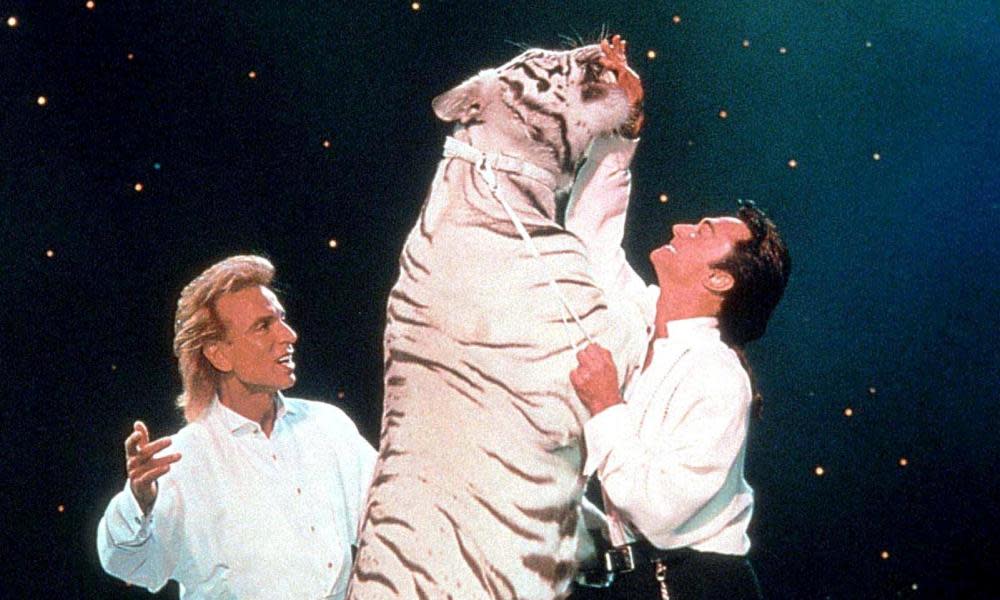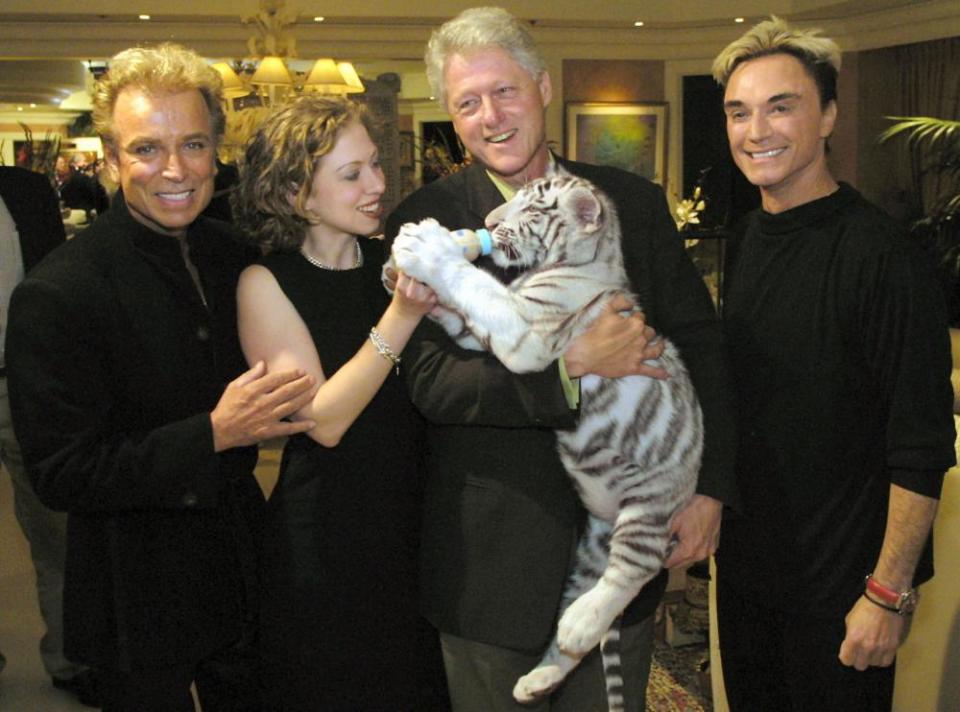‘It took four men and a fire extinguisher to get the tiger off him’: the tragedy of Vegas magicians Siegfried and Roy

Where do you start with a story that involves counter-terrorism police doing background checks on a tiger, has its roots in the mental health problems of Nazi soldiers, and features an investigation into whether a beehive hairdo can be used as a weapon? What’s more, weaving in and out of all of this, there are two German magicians in mullets and shiny suits seemingly capable of floating around in the air, one of whom nearly dies on stage after a white tiger bites clean through his neck.
This was the problem facing Emmy-winning film-maker Steven Leckart, who had long felt that the extraordinary story of Siegfried and Roy, whose performances with exotic animals electrified Las Vegas, deserved a proper telling. The result is Wild Things, an eight-part podcast detailing how Siegfried Fischbacher and Roy Horn rose to international stardom with a whole zoo’s worth of performing jungle cats, then had their live career effectively ended when a tiger called Montecore attacked Roy on stage, nearly killing him.
“As a child of the 80s,” says Leckart, speaking via Zoom from his Los Angeles home, “Siegfried and Roy have always loomed large for me. And no one has ever properly examined their story – or the attack – in depth.” To do so was a mighty undertaking: over the course of 50 years, Siegfried and Roy performed 30,000 shows to 50 million people, generating over $1bn in ticket sales. Their act fused gigantic, mind-boggling illusions with the most exotic animals on earth, sparking an explosion in families coming to Vegas shows, at a time when bills were dominated by topless showgirls.

The duo suspended tigers above crowds on flaming disco balls and made elephants vanish into thin air. After their shows, they would hang out with their jungle cats in their suite at the Mirage hotel, before returning to their $10m Moroccan-style villa the Jungle Palace, or their 100-acre residence Little Bavaria, where German marching music played through concealed speakers.
Their celebrity acquaintances included Michael Jackson (who wrote them a theme song), David Lee Roth (who gifted them goats) and Pope John Paul II (who gave them a fragment of Saint Francis of Assisi’s shinbone). In 1998, the then US President Bill Clinton joined them after a show, his secret service sharpshooters training their weapons on the tigers. A Saturday Night Live spoof had them introducing a special Night of a Thousand Tigers.
“They were hyperbole manifested,” says Leckart. “Everything about them was bigger, was louder, was dialled up to 11, which is a deliberate Spinal Tap reference. But what kept them going for so many years was their incredible skill and the way they progressed their show.”
Wild Things takes listeners through this journey, which has surprisingly sad origins in Germany. Both Siegfried and Roy’s fathers were violent, rage-filled alcoholics, scarred by years of fighting as Nazi soldiers. Roy’s lifelong love of animals started when he adopted a stray dog that protected him and his mother from his father’s fists. Siegfried sought refuge in magic, teaching himself tricks from books after watching an entertainer swallow razor blades in a town square.

The budding illusionists met as teenagers on a German cruise ship, where Roy worked as a bellboy after fleeing his family and Siegfried was a steward with a magic show in the evening. Unimpressed by the spectacle of rabbits being disappeared from hats, Roy decided to scale things up and get him a cheetah instead, so smuggled one out of a zoo. It marked the start of their signature fusion of magic and jungle cats. Legend has it that a furious captain kicked them off the ship, but Leckart tells a different story: “I heard that the captain was really mad about it, but the crowd loved it so much that he let them carry on.”
In 1966, the duo’s big break came when Grace Kelly (AKA Princess Grace of Monaco) invited them to perform at her annual Red Cross gala in Monte Carlo. Their cheetah, Chico, fled through a celebrity-packed crowd, straight past Kelly and into the kitchens. When Siegfried nonchalantly jumped off the stage, the crowd assumed it was all part of the act. A standing ovation and newspaper headlines followed.
Within a few years, they were regular performers in Vegas, before bagging a headline slot with the city’s first full-length magic show. Eventually, a rival hotel would poach them in a flamboyant stunt in which they were helicoptered in to sign a $57m contract. Their new venue had 1,500 seats and it sold out, twice a night, for a decade.

Listening to Wild Things – its first two episodes have just dropped – you do wonder: “Isn’t some of this cruel to animals?” We hear lively stories about the magicians removing baby tigers from their mother. A supposedly humorous anecdote involves a panther bursting a waterbed after it’s locked in a bedroom during a party, while a pacy anecdote about two tigers being stolen does rather skip over the fact that they had been left outside a deli locked in the back of a truck. This can’t all be OK, can it? “We do go – in depth – into the question of animal welfare and safety in a subsequent episode,” says Leckart. “What we uncover is not just shocking, but really disturbing.”
Initially, though, Wild Things concerns itself with the 2003 tiger attack. By the time it happened, Siegfried and Roy had been performing alongside exotic animals for 44 years, repeating the same show every night for an entire decade. It was so routine that – as the cast left Roy on stage to deliver a spotlit monologue to seven-year-old white tiger Montecore – they knew every word and gesture that was coming. Or so they thought.
Montecore bites Roy through the neck, slicing his vertebrae and severing an artery that cuts off the blood to the right side of his brain. He drags Roy about, coating the stage in so much blood that one onlooker says: “I’m thinking to myself, ‘He’s gone. He’s not going to make it, man.’ This was fucking hell on earth.” Another shocked voice says: “It took four men and a fire extinguisher to get the tiger off him.”
In the ambulance, Roy manages to gasp: “Montecore is a great cat. Make sure no harm comes to Montecore.” Soon he is flatlining in hospital and the Mirage car park is filling up with praying, weeping fans. Police enter the hotel to find drinks abandoned on tables and a stage still slicked with blood. So intense is the media spotlight that the police decide to use officers normally assigned to counter-terrorist cases. The question is: was the tiger attack a crime?
And this is where the podcast, which had been compelling enough, really shifts into another gear. It would be unfair to give away its many surprises but (spoiler alert) Leckart’s team discover that the investigation entered truly bizarre territory, including animal activists, homophobes in the crowd, ultrasonic devices and a woman near the stage with a large beehive hairdo. Montecore’s background is probed, too.

“This is why we called the podcast Wild Things,” says Leckart. “We would just find new and wild bits of information at every turn. What’s even more bizarre is the separate investigation into animal cruelty by the USDA. The twists and turns of where that goes is bananas.”
Roy was left partially paralysed on the left side of his body. He claimed that Montecore didn’t actually attack him, insisting that he had suffered a stroke and the tiger was trying to take him to safety. He continued to live with Montecore until the jungle cat’s death in 2014. To this day, there has been no widely accepted explanation of the incident, which led to the Mirage closing the show.
Leckart, however, thinks he’s succeeded where the counter-terrorism detectives failed. “We absolutely solve the question of what happened with the attack,” he says. “We come to a very clear conclusion. My view on the cause changed throughout the making of the series. But you will not leave the podcast without forming an opinion on what happened.”
Roy died of Covid in May 2020 at the age of 75. Siegfried succumbed to pancreatic cancer the following January. He was 81. Both had retired from showbusiness a decade earlier.
Siegfried and Roy were the highest paid magicians Vegas had ever had and a statue to them now stands outside the Mirage. They pulled off extraordinary stunts night after night, but their greatest illusion was ultimately, and tragically, exposed: the idea that these beautiful, exotic creatures could be tamed. “A wild animal is always a wild animal,” we hear Roy say early on. “Don’t ever forget that.”

 Yahoo News
Yahoo News 
